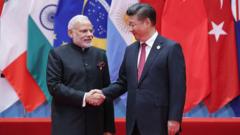DeepSeek's success showcases China's resilience and innovation amid US tech sanctions, turning adversity into progress.
**DeepSeek's Rise: China's AI Innovators Challenge US Tech Dominance**

**DeepSeek's Rise: China's AI Innovators Challenge US Tech Dominance**
China's DeepSeek AI shakes industry and defies American export restrictions in a landmark achievement.
DeepSeek has emerged as a game-changer in the world of artificial intelligence as it releases a powerful AI model that astonishes Silicon Valley and the global tech community. While many speculated that US tech curbs would hinder China’s advancements, DeepSeek’s entry highlights the ingenuity of its engineers and the depth of China’s tech ambitions. Two years post-ChatGPT, critics in the US are forced to reconsider their assumptions about who leads the AI charge.
Initially seen as trailing ChatGPT, Chinese tech firms faced mockery as their products, including Baidu's Ernie, were deemed inferior. The US, buoyed by restrictive measures against China’s access to advanced technology, felt secure in its tech dominance. However, that perception began to shift dramatically when DeepSeek introduced its AI model, touted as both potent and affordable, leveraging a significant stockpile of Nvidia chips acquired before the US embargo.
Despite the adversities posed by chip import bans, experts note that these restrictions have inadvertently spurred innovation within the Chinese tech ecosystem, fostering a new wave of creativity and autonomy to tackle challenges. DeepSeek's founder, Liang Wenfeng, emphasized the company's approach to maximizing resources, training its AI model with a combination of 2,000 advanced chips and a host of lower-grade alternatives.
Moreover, Liang's narrative—rooted in a passion for innovation and self-sufficiency—mirrors the aspirations of China's government to cultivate a robust tech ecosystem. The recent launch of DeepSeek was strategically timed, aligning with a shift in US leadership, casting a spotlight on the resilience of Chinese operators.
The growth of DeepSeek represents a shift toward foundational research over short-term gains in China. The company's team, largely composed of young graduates from elite universities, embodies a fresh entrepreneurial spirit, eager for self-reliance in AI development. Liang himself epitomizes this ideal, enhancing DeepSeek’s reputation as an open-source platform that promotes collaborative innovation.
While DeepSeek celebrates its newfound acclaim, doubts linger regarding how the company will continue to secure advanced technological resources and data necessary for scaling its capabilities against the backdrop of ongoing US restrictions. However, for now, DeepSeek stands as a testament to China’s rapid technological ascent—a renowned AI model sparking excitement across social media and positioning itself as a symbol of national pride during the Lunar New Year celebrations. Tech enthusiasts in China are increasingly rallying behind this innovation, intrigued by the promise it holds for the future of AI.
Initially seen as trailing ChatGPT, Chinese tech firms faced mockery as their products, including Baidu's Ernie, were deemed inferior. The US, buoyed by restrictive measures against China’s access to advanced technology, felt secure in its tech dominance. However, that perception began to shift dramatically when DeepSeek introduced its AI model, touted as both potent and affordable, leveraging a significant stockpile of Nvidia chips acquired before the US embargo.
Despite the adversities posed by chip import bans, experts note that these restrictions have inadvertently spurred innovation within the Chinese tech ecosystem, fostering a new wave of creativity and autonomy to tackle challenges. DeepSeek's founder, Liang Wenfeng, emphasized the company's approach to maximizing resources, training its AI model with a combination of 2,000 advanced chips and a host of lower-grade alternatives.
Moreover, Liang's narrative—rooted in a passion for innovation and self-sufficiency—mirrors the aspirations of China's government to cultivate a robust tech ecosystem. The recent launch of DeepSeek was strategically timed, aligning with a shift in US leadership, casting a spotlight on the resilience of Chinese operators.
The growth of DeepSeek represents a shift toward foundational research over short-term gains in China. The company's team, largely composed of young graduates from elite universities, embodies a fresh entrepreneurial spirit, eager for self-reliance in AI development. Liang himself epitomizes this ideal, enhancing DeepSeek’s reputation as an open-source platform that promotes collaborative innovation.
While DeepSeek celebrates its newfound acclaim, doubts linger regarding how the company will continue to secure advanced technological resources and data necessary for scaling its capabilities against the backdrop of ongoing US restrictions. However, for now, DeepSeek stands as a testament to China’s rapid technological ascent—a renowned AI model sparking excitement across social media and positioning itself as a symbol of national pride during the Lunar New Year celebrations. Tech enthusiasts in China are increasingly rallying behind this innovation, intrigued by the promise it holds for the future of AI.





















